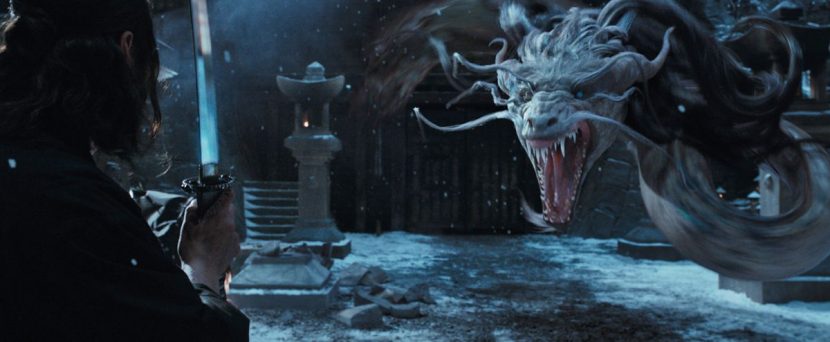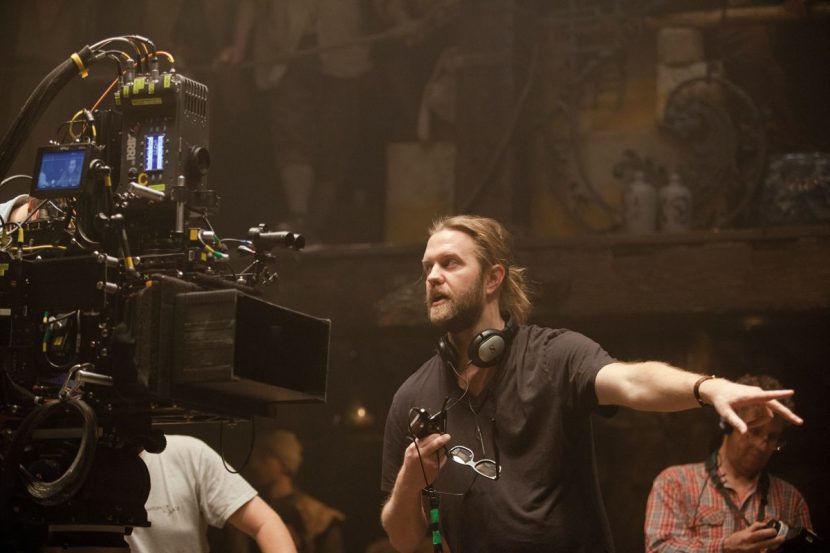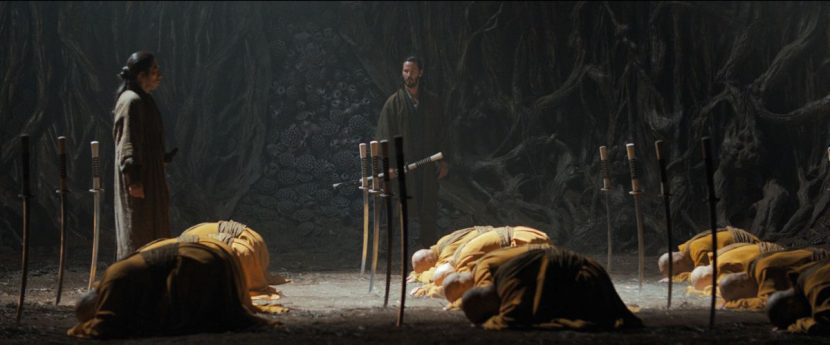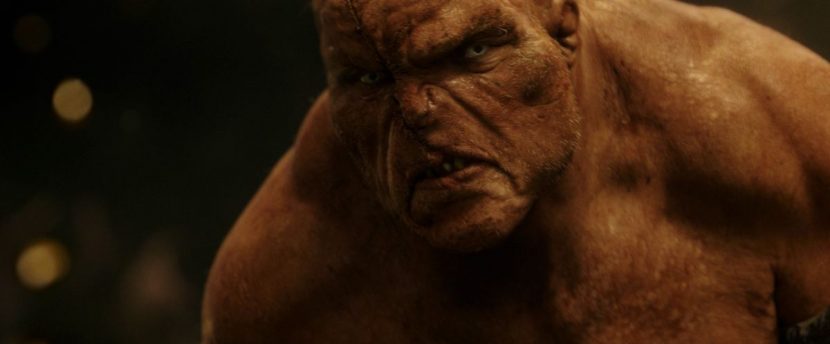47 Ronin visual effects supervisor Christian Manz says that director Carl Rinsch’s vision for the epic film – based on a famous Japanese tale – was that it had to feel very Japanese even if it was being told as a fantasy. “Carl’s idea was that, yes, we had to set this in Japan,” recalls Manz, “but a fantasy Japan than people might imagine have existed.”
Filmed mostly in Hungary by DOP John Mathieson, with additional backlot and location work undertaken in the UK, 47 Ronin was also shot in native stereo on the ARRI Alexa with Camera/Pace stereo rigs. A team of artists worldwide from Framestore, MPC, Baseblack, Milk VFX and Soho VFX created the film’s visual effects. We take a look at four of the major effects sequences in the film – the witch transformations, the Kirin, Tengu battle and the Oni.
The witch transforms

The evil witch Mizuki (Rinko Kikuchi), who appears in various guises throughout the film, wreaks havoc on the Ronin. For a scene of Mizuki in the form a giant serpent-like dragon battling Kai (Keanu Reeves), Framestore concocted a transforming beast from human to creature.
Although there would be a clear transformation, director Rinsch and Manz looked to enable the change in a way that wasn’t a typical morph. “The main thing I wanted to get out of the actress was to do a move that would drive the transformation,” says Manz. “There are two shots where she arrives at that courtyard and I simply got her to crouch down and then stand up, so that as we have the cloth drop down on her and reveal her from underneath it looked like a continuous thing. And when she turns into the dragon I simply got her to do a spin so her real dress was spinning around in a cool way that we could take over into a spinning CG cloth and lose her quite quickly.”
“All the time it was to try and do something that was beautiful yet threatening,” adds Manz. “Behind that the head appears – you feel like you’ve seen the transition but you haven’t really. I wasn’t that keen on having a bit cloth grow horns and teeth – I just wanted something that looked elegant and continuous. I pitched the dragon as – imagine the fight is underwater but it’s actually dry land and the snow is like the plankton, an eel-like movement. It was something a bit different from our Western view of a dragon.”
Framestore visual effects supervisor Mike Mulholland, who shared duties with Sirio Quintavalle, describes the transformation of the witch into the dragon as “a multistage effect because the witch herself goes from cloth into human form, then human to cloth, then cloth to dragon, so there was no straight transformation of human to dragon. It was done by taking advantage of the actress’ movement’s where she did this violent spin and as her robes rose up we were able to augment the spin, exaggerate it and take over the actress with CG cloth and use that CG cloth to wipe and remove her.”
To make the cloth fly and snake around in the appropriate way, Framestore used a combination of techniques. Where real cloth required augmentation, artists performed body tracking and integrated sims into the actress’ real clothes “to almost find areas where we could tick in the CG cloth into existing parts of her garment, be it her belt or robe, almost as a secondary layer of cloth,” says Mulholland.
Behind the work
Here’s how the VFX in 47 Ronin broke down between facilities:
Framestore – Kirin, the witch transformations, Tengu, several environments
MPC – Oni, Dutch Island and other environments, the fiery Ronin ambush
Digital Domain – Kira’s province and surrounding environments
Baseblack – matte paintings, 2d fixes and composites
Milk VFX – spirits in Tengu forest, matte paintings
Soho VFX – environment establishing shot
Fully CG views required an FX or Creature rig to drive the cloth according to certain timings. “At the end of the day,” explains Mulholland, “we ended up with a combination of soft constraints to almost pull the cloth like it was on wire and being very particular about when we activated those, so we had to imagine it was a real piece of cloth and we were pulling it around but also pushing air currents onto it. After many iterations we tried to bank areas of the sim, so if we found the latter half worked and we were still working on the first half we would try and maintain the section that worked and blend it with other areas we were happy with.”
“The transformation from cloth to dragon took advantage of the dragon being a snake-like shape,” says Mulholland, “which lent itself to a long flow path. So by taking the dragon’s animation and mapping out the path of how it moved we were able to a form a path for the CG cloth to travel along and then by matching the scale and size of the cloth to the dragon, and also the speed and timing, we were able to come up with a motion which enabled us to signify that the cloth was transforming into the dragon. The switch was handled by moving behind and around pillars but because the motion was matched it didn’t feel like a sudden break – it was more of a natural flow. We also did some colour transitions of the cloth from green to white as it became more sympathetic to the dragon’s colouring.”
In compositing, Framestore used the cloth to wipe either on or off the witch herself or to finesse the timing and shape of the cloth. “There are numerous shots where you see her turn back into the human witch from the cloth and we had to time how the cloth moved to make one end cling to her while the other end descended across her and wiped to do a reveal,” notes Mulholland. “So basically it was trial, error, a lot of iterations and a lot of backwards and forwards with the client and the VFX Supervisor. The team spent a lot of time on the witch and did a pretty remarkable job I think considering the limitations of directing cloth.”
A run-in with the Kirin
Watch part of the Kirin hunt in this video.The film opens with the samurai – who are not yet Ronin – pursuing a Kirin, a large creature from Japanese mythology. The animal has been poisoned by the witch Mizuki. Framestore modeled and animated a beast to insert into live action photography of the Kirin hunt.
On location in the woods of UK, the filmmakers captured action with the stereo rigs attached to a Russian Arm, generating footage that would later involve meticulous stereo tracking due to the bumpy ground. They also dragged an SFX rig through greenery to get an idea of interaction with the Kirin, but ultimately most of this would be accomplished in CG and with particle effects. “Kai also ends up underneath the Kirin, and lunges at it with a sword, and then is dragged for a while,” says Manz. “For one shot we strapped Keanu Reeves on an arm with an ATV dragging him with a camera looking down through ferns. We put some shadows of legs over the top of him and added ferns over the top to give some more dynamism of the shot.”
“Part-way through the sequence,” adds Manz, “the Kirin smashes through a cart and snares the horse attached to the cart and drags the horse across a field. Eventually the samurai catch up and cut the horse loose. Practically we had a cart there and SFX had a rig to blow it apart with high pressure air. We had a real horse there but then we had to do a full-CG horse. We did lay down a real horse on a sled and drag it at 30 miles an hour across a field. He did it once – the first time he was flailing everywhere and it looked great, but the second time he just lay there – he rather enjoyed it, I think.”

The Kirin itself combined elements of a horse, bison and bull, with the later closely followed for its unpredictability of movement. “What we honed in on for the design was something that we felt was Japanese, looking like what one might be painted like,” recalls Manz. “It had six eyes but doesn’t open all of them until it’s really hunting right at the end.”
In animating the Kirin, Framestore had to ensure the enormous weight of the creature was conveyed properly. “As well as an animation challenge where they’ve got to make sure that it reads and it’s got enough weight,” explains Mulholland, “we had to augment the animation with a number of things – a CG muscle layout that would respond and bounce according to the animation, react to footfalls and show weight.”
“Then the Kirin has a large mane,” continues Mulholland, “so we took a similar approach to that as we had used with Aslan in the past. The groom was a set of guide hairs so we were able to simulate those and feed them back into the hair system to get it to respond as the creature moved. We used our proprietary in-house hair systems to get the fur to react to the creature’s movement but also to deal with the collisions between the individual hairs, the body and the other objects in the scene. Then finally there’s the occasional comp trickery used to add a little bit of camera shake to the shot so you got a real sense that it was hitting the ground.”
When Tengu Monks attack
See the Tengu attack sequence.The Ronin encounter a group of monks who at first appear motionless but then fight them with super-human speed and teleportation-like abilities. “Carl’s brief was that they were bird-like men,” says Manz, “but you had to imagine what if a child saw one of these guys in a forest, that’s what the kid would draw – a bird, but a twisted version. Their teleporting involved leaving cloth trails – Carl wanted it to be like a living sculpture in the air.”
To film the sequence and achieve a desired ‘cloth trail’ effect, Manz began with a motion control shoot on set in Budapest. “We got stunt guys who were all the same build,” recounts Manz, “so when you had one Ronin fighting a Tengu he was fighting three people who would leap in and out and do their bit of choreography and leap out of shot. We would paint them out and then join them with a cloth trail to the next person. We did that for some shots, but the problem became, could the stunt guys in reality move quickly enough to do what we needed them to do?”
This meant that Framestore launched into an R&D effort to achieve the shots with CG Tengu warriors and cloth trails rendered in Arnold based on the VFX studio’s art department concepts. “I shot a test and I worked with them to come up with a single image of a cloth trail and Tengu at the end,” says Manz. “That became the bible for the sequence.”

“The problem with doing cloth simulations,” notes Mulholland, “is that they don’t work if you change the topology of the geology over time and because the Tengu monks were forming trails effectively you’re saying that the tube behind the monk is changing over time so it makes it impossible to simulate with normal techniques. The approach we took was to map the four-dimensional behaviour of the monk so as it moved across the length of the shot we would create a tunnel that represented the monk’s path by outputting the monk’s position for every frame and between frames to form a trail of particles which we then surfaced to make a tube.”
“The tube at that point didn’t collapse,” adds Mulholland, “it was just a single static tube behind them that represented their movement throughout the shot, so if you showed the tube and the monk you would see the monk moving through the tube as the sequence progresses. The second stage was then to collapse that tube, so we needed to make it into cloth and make it respond. The trick was to have the timing of the tube’s collapse to sync up with the moment in time when the monk moved through that position in the tube, so we’d have the static tube and anything behind the monk as it ran through it would start to collapse and respond in a cloth-like manner. We then took that deforming, collapsing tube and on a per frame level we applied that tube’s deformation to a new trail that the monk would make.”
That gave Framestore the ability to make a growing trail that had different topology per frame but then would collapse and deformed like cloth. “It was a tricky task and it required us to think in four dimensions,” says Mulholland, “which was a bit of a leap, but once we got it working it was an effective solution to the brief and quite a fun challenge to do with cloth – a mixture of animation and FX – quite a complicated thing to have to wrangle because it was both simulating cloth and dealing with the FX side, which made it quite tie consuming and difficult to iterate.”
Face-off with an Oni
The fierce Oni creature is featured in this clip.On Dutch Island, Kai engages in some close-combat with an Oni, a fierce demon ogre creature tinged with red. On set, Keanu Reeves battled with stunt performer Neil Fingleton. “He’s one of the world’s biggest stuntmen – 7 foot 8,” describes Manz. “I wanted to have someone doing the choreography and moving at the right speed, and then we would replace him.”
That task fell to MPC, who worked the fighting footage and clean plates. “Neil wore a very fetching orange leotard with tracking dots all over him,” says Manz. “We also had witness-cams running. It means you’ve got something the director can direct on set and something to cut with. It was then turned over to MPC, and Neil’s performance became a guide, but we weren’t beholden to that.”
MPC, led by visual effects supervisor Nicolas Aithadi, looked also to some additional motion capture for body and facial movements of a performer with a similar build – although not height – to the Oni. “Once we received the sequence at MPC, we decided to hire a model who had a body that had the same kind of features the Oni had,” says Aithadi. “We set up a 4 camera shooting rig and had him act out the part of the Oni. This gave us a great collection of reference material. The original idea was to rotoscope the live action stunt man present in the plate and apply the animation to our CG model, but quickly the choreography of the fight evolved with the design of our creature and we ended up key framing every shot from scratch. We only made sure that the original interactions remained.”
For the Oni’s skin, muscle and clothing effects, MPC looked to take their character work to a more detailed level. “One of the first elements we wanted to integrate into the system was the idea of muscle weight,” describes Aithadi. “This meant that not only did each muscle need to react to the body movement, but they also needed to respond to gravity. This gave us very realistic pectorals for instance.”

“Beside the dynamic system we also used the traditional techniques of adding to it with blend shapes,” adds Aithadi. “We watched countless reference videos, including those shot with the model we hired, but also from various other sources, to understand what would make the body more realistic. Every time we added detail, we would found that something was missing and we would dive back into our references.”
The Oni wields a Kusarigama – a ball and chain weapon – against Kai. For this, the animators animated the handle with the Oni’s hand and then keyframe where the ball would end up. “The rig had an alert system if the ball was going to far for the length of the chain,” says Aithadi. “Once the animation was approved, the techAnimation department took over and simulated the chain. Every time the ball hit an element of the set the FX artists would generate CG splinters, and a matte painting of the damage was comped in.”
All images and clips copyright 2013 Universal Pictures. All rights reserved.
